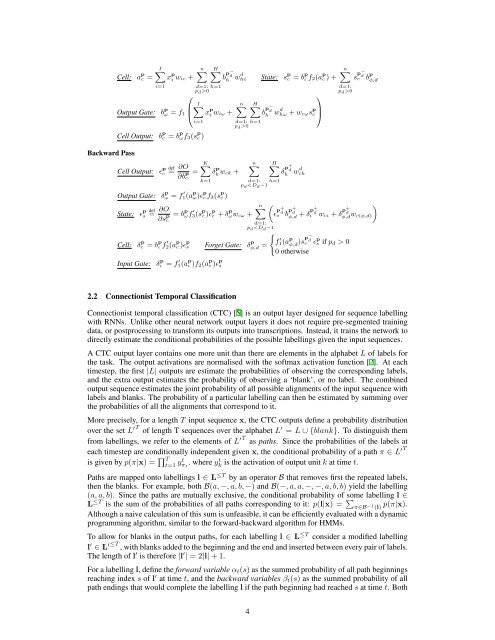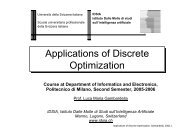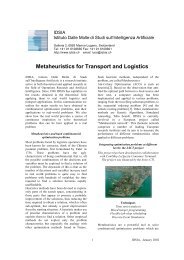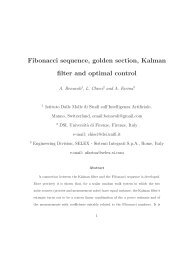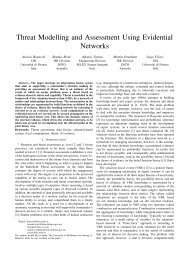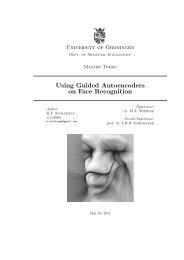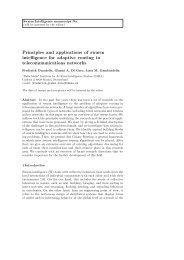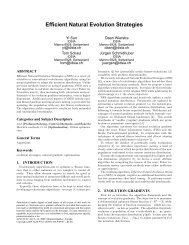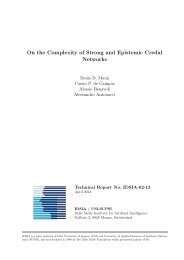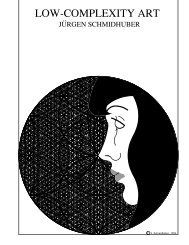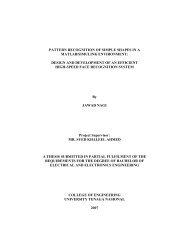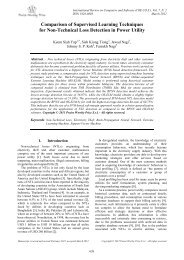Offline Handwriting Recognition with Multidimensional ... - Idsia
Offline Handwriting Recognition with Multidimensional ... - Idsia
Offline Handwriting Recognition with Multidimensional ... - Idsia
Create successful ePaper yourself
Turn your PDF publications into a flip-book with our unique Google optimized e-Paper software.
Backward Pass<br />
Cell: a p c =<br />
IX<br />
x p i wic +<br />
i=1<br />
0<br />
Output Gate: b p B<br />
ω = f 1 @<br />
n<br />
X<br />
HX<br />
d=1: h=1<br />
p d >0<br />
IX<br />
x p i wiω +<br />
i=1<br />
Cell Output: b p c = b p ωf 3(s p c )<br />
Cell Output: ɛ p c<br />
def<br />
= ∂O<br />
∂b p c<br />
=<br />
KX<br />
δ p k w ck +<br />
k=1<br />
Output Gate: δ p ω = f ′ 1(a p ω)ɛ p c f 3(s p c )<br />
State: ɛ p s<br />
def<br />
= ∂O<br />
∂s p c<br />
b p− d<br />
h wd hc State: s p c = b p ι f 2(a p c )+<br />
n<br />
X<br />
HX<br />
d=1: h=1<br />
p d >0<br />
= b p ωf ′ 3(s p c )ɛ p c + δ p ωw cω +<br />
nX<br />
b p− d<br />
h<br />
d=1: h=1<br />
p d 0<br />
0 otherwise<br />
Input Gate: δ p ι = f ′ 1(a p ι )f 2(a p c )ɛ p s<br />
«<br />
2.2 Connectionist Temporal Classification<br />
Connectionist temporal classification (CTC) [5] is an output layer designed for sequence labelling<br />
<strong>with</strong> RNNs. Unlike other neural network output layers it does not require pre-segmented training<br />
data, or postprocessing to transform its outputs into transcriptions. Instead, it trains the network to<br />
directly estimate the conditional probabilities of the possible labellings given the input sequences.<br />
A CTC output layer contains one more unit than there are elements in the alphabet L of labels for<br />
the task. The output activations are normalised <strong>with</strong> the softmax activation function [2]. At each<br />
timestep, the first |L| outputs are estimate the probabilities of observing the corresponding labels,<br />
and the extra output estimates the probability of observing a ‘blank’, or no label. The combined<br />
output sequence estimates the joint probability of all possible alignments of the input sequence <strong>with</strong><br />
labels and blanks. The probability of a particular labelling can then be estimated by summing over<br />
the probabilities of all the alignments that correspond to it.<br />
More precisely, for a length T input sequence x, the CTC outputs define a probability distribution<br />
over the set L ′T of length T sequences over the alphabet L ′ = L ∪{blank}. To distinguish them<br />
from labellings, we refer to the elements of L ′T as paths. Since the probabilities of the labels at<br />
each timestep are conditionally independent given x, the conditional probability of a path π ∈ L ′ T<br />
is given by p(π|x) = ∏ T<br />
t=1 yt π t<br />
. where yk t is the activation of output unit k at time t.<br />
Paths are mapped onto labellings l ∈ L ≤T by an operator B that removes first the repeated labels,<br />
then the blanks. For example, both B(a, −, a, b, −) and B(−, a, a, −, −, a, b, b) yield the labelling<br />
(a, a, b). Since the paths are mutually exclusive, the conditional probability of some labelling l ∈<br />
L ≤T is the sum of the probabilities of all paths corresponding to it: p(l|x) = ∑ π∈B −1 (l) p(π|x).<br />
Although a naive calculation of this sum is unfeasible, it can be efficiently evaluated <strong>with</strong> a dynamic<br />
programming algorithm, similar to the forward-backward algorithm for HMMs.<br />
To allow for blanks in the output paths, for each labelling l ∈ L ≤T consider a modified labelling<br />
l ′ ∈ L ′ ≤T , <strong>with</strong> blanks added to the beginning and the end and inserted between every pair of labels.<br />
The length of l ′ is therefore |l ′ | =2|l| +1.<br />
For a labelling l, define the forward variable α t (s) as the summed probability of all path beginnings<br />
reaching index s of l ′ at time t, and the backward variables β t (s) as the summed probability of all<br />
path endings that would complete the labelling l if the path beginning had reached s at time t. Both<br />
4


